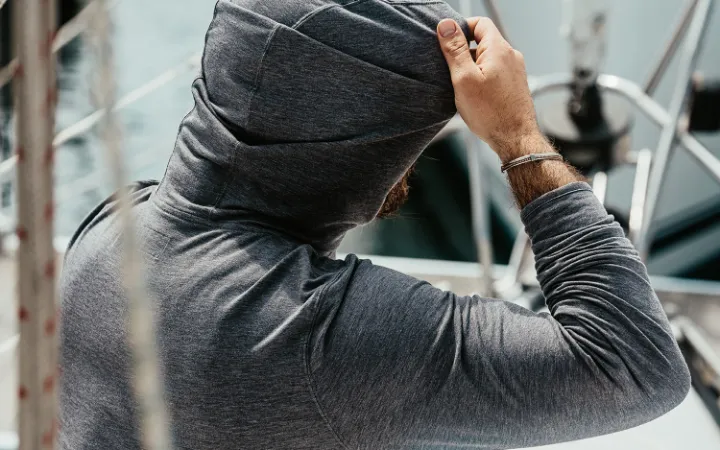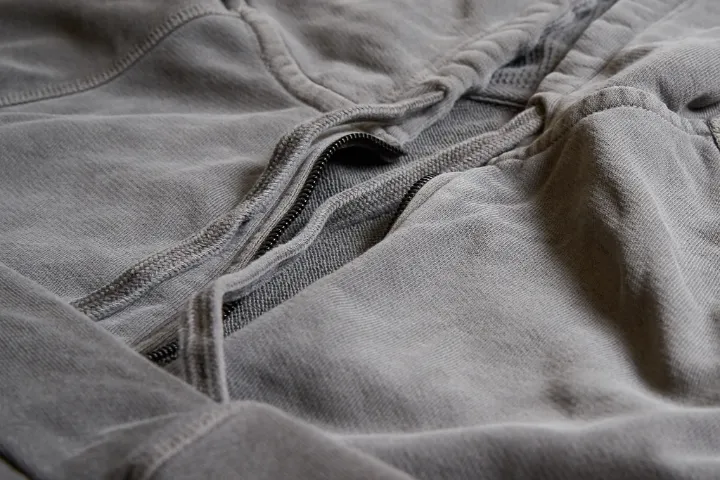No products in the cart.
Blog
From Cotton To Wearing: How Much Does A Hoodie Weigh?
The weight of a hoodie can vary significantly, influenced by factors such as material, design, and size. While we may not often think about it, understanding the weight of a hoodie can be quite insightful.
From the perspective of comfort, durability, to even environmental impact during the production phase, the weight of a hoodie holds more importance than one might assume. So, let’s delve into the question: “How Much Does a Hoodie Weigh?” and explore the factors that determine its weight.
The Hoodie: A Brief History and Cultural Significance

The origins of the hoodie can be traced back to the ancient Greeks and Romans, where workers and monks wore tunics with hoods for practicality and protection from the elements. However, the modern hoodie as we know it was born in the 1930s in the United States, specifically designed and manufactured by Champion for laborers in freezing New York warehouses.
The hoodie began its journey into the mainstream in the 1970s when it was adopted as a fashion statement by the burgeoning hip-hop culture in New York City. It later gained further prominence and cultural significance in the 1980s and 90s, becoming associated with the rebellious spirit of the grunge and skateboard subcultures. The hoodie was not just a garment, but a symbol of individuality and defiance against the status quo.
Today, the hoodie transcends age, gender, and geography. It’s a staple in wardrobes worldwide, embraced by streetwear enthusiasts and high fashion designers alike. The weight of a hoodie has become an essential aspect of its design and functionality, influencing its fit, warmth, and comfort. As we’ll see, the weight of a hoodie is not just dictated by the type of fabric used, but by several other factors that we’ll explore in this post.
Different Materials and Their Impact on Hoodie Weight

Cotton Hoodies
Cotton hoodies are a popular choice for their breathability and softness. They tend to be heavier, especially if they’re made from 100% cotton. The specific weight can vary based on the thickness of the fabric, but on average, a cotton hoodie can weigh anywhere from 450 to 900 grams.
Polyester Hoodies
Polyester hoodies are known for being lightweight and durable. They are often chosen for sportswear due to their sweat-wicking properties. A typical polyester hoodie can weigh in the range of 300 to 600 grams, depending on the thickness and size.
Fleece Hoodies
Fleece is another commonly used material for hoodies. Known for its warmth and soft texture, fleece hoodies are heavier than their polyester counterparts but lighter than cotton. A fleece hoodie usually weighs between 400 and 800 grams.
Blend Hoodies
Blended hoodies often use a mix of cotton and polyester. This combination offers the benefits of both materials, balancing comfort and durability. The weight of these hoodies falls somewhere between that of cotton and polyester hoodies, typically weighing between 350 and 700 grams.
Organic Material Hoodies
Organic material hoodies, such as those made from bamboo or hemp, are gaining popularity. They provide sustainability and superior softness but tend to be on the lighter side. The weight of an organic material hoodie can vary greatly, but it generally weighs between 300 and 600 grams.
Polyester Hoodies: The Lightweight Champions

When it comes to lightweight comfort, polyester hoodies are the undisputed champions. These hoodies benefit from the inherent properties of polyester, a synthetic material valued for its durability and lightness.
Despite their featherweight, they excel in weather resistance, offering excellent protection from wind and rain while effectively wicking away sweat during physical activities. The low weight does not compromise the warmth they provide, making them an ideal choice for a range of climates and seasons.
Whether it’s for a brisk morning jog or an outdoor evening workout, a polyester hoodie’s combination of lightness and performance is hard to beat.
Going Green: The Weight of Organic Material Hoodies
Organic material hoodies, often crafted from materials like hemp, bamboo, or organic cotton, are a fantastic eco-friendly alternative. While they tend to be lighter compared to traditional fabric hoodies, they do not skimp on comfort and softness.
The weight of these green hoodies can range greatly, generally resting between 300 and 600 grams. However, the selling point of these hoodies goes beyond their physical attributes. Their production process respects the environment, reducing pollution and conserving resources, thus making them a sustainable wardrobe choice for the environmentally conscious.
With organic material hoodies, you’re not just wearing a piece of clothing – you’re wearing a statement of care for our planet.
The Role of Size in Determining Hoodie Weight

Size and Weight: A Direct Relationship
Unsurprisingly, size plays a significant role in determining the weight of a hoodie. The larger the hoodie, the more fabric it requires, and consequently, the heavier it becomes. A small-sized hoodie will weigh less than a larger one made of the same material.
Weight Range by Size
To give you rough estimates, a small-sized hoodie can weigh anywhere between 250 and 400 grams, while a medium-sized one can weigh between 300 and 500 grams. On the other hand, large hoodies can weigh between 400 and 600 grams. It’s important to note, however, that these figures can vary depending on the fabric used.
Size Variations Across Brands
Just as clothing sizes can vary from brand to brand, so too can the weight of hoodies. Some brands may use denser fabrics or include additional features like double lining or large graphic prints, which can add weight. Therefore, a medium-sized hoodie from one brand may weigh more or less than a medium from another brand.
Extra-Large Sizes and Their Unique Weights
When it comes to extra-large sizes, such as XL and XXL, the weight can reach up to 700 to 900 grams, again depending on the material. These sizes require considerably more fabric, which naturally increases the weight.
Size vs. Comfort: A Balancing Act
While size does affect the weight of a hoodie, it’s essential to remember that comfort should be your primary consideration. After all, the purpose of a hoodie is to keep you cozy and warm. A slightly heavier hoodie may be better if it fits you well and keeps you comfortable, even if it weighs a little more.
Additional Factors Influencing Hoodie Weight

Design and Construction
The design of a hoodie can significantly influence its weight. A basic pull-over hoodie without any extra features will weigh less than a zippered one or a hoodie with pockets and additional design elements. The quality and thickness of the stitching, the type of zippers, and the presence of drawstrings or hoods also contribute to the overall weight.
Hoodie Lining
The type of lining in a hoodie contributes to its weight and warmth. A hoodie lined with fleece or a similar material will be heavier than one without. Additionally, double-lined hoodies offer extra warmth and durability, but they also add to the overall weight.
Print and Embellishments
The presence of graphics, prints, or embellishments on a hoodie can also affect its weight. Large, elaborate designs or heavy embellishments like sequins or beads can add significant weight. Contrastingly, hoodies with minimal design or just a simple logo will be lighter.
Washing and Wear
The weight of a hoodie can change slightly over time with washing and wear. Regular washing may cause the fabric to become lighter as it wears out. However, the change is typically minimal and may not be noticeable without precise measurement equipment.
Manufacturing Process
The manufacturing process and the quality control standards of the hoodie brand can influence the weight as well. High-end brands that use dense weaving techniques and quality materials will produce heavier, more durable hoodies. On the other hand, cheaper brands may use looser weaves and lighter materials to reduce costs, resulting in lighter hoodies.
The Influence of Manufacturing Process on Hoodie Weight

Factors in Manufacturing Process
The manufacturing process of a hoodie has a tremendous influence on its weight. The type of weave used in creating the fabric, for instance, can significantly impact the weight. A tighter weave will typically produce a heavier and more rugged hoodie, while a looser weave results in a lighter, more breathable garment.
Additionally, the process of dyeing the fabric can add to the weight. Some dyes penetrate deeply into the fabric, adding extra weight. Furthermore, the number of washes a hoodie undergoes during production can marginally influence the weight – more washes can lead to a slightly lighter garment.
Quality Control in Manufacturing Process
Quality control during the manufacturing process also affects the weight of the hoodie. Brands with strict quality control standards often produce heavier, more durable hoodies. They ensure that the materials used are of high quality, and the construction is robust, which naturally results in a heavier end product.
On the other hand, brands with less stringent quality control may use lighter materials and thinner threads for stitching to cut costs, consequently producing a lighter hoodie. However, these hoodies may not be as durable or long-lasting.
Innovation in Manufacturing Process
Innovation in the manufacturing process can also influence hoodie weight. With advancements in technology, some manufacturers have been able to develop lightweight fabrics that retain the warmth and durability of heavier ones. For example, using advanced knitting technology, manufacturers can create ultralight hoodies that offer excellent thermal insulation.
Moreover, new techniques like laser-cutting and seamless construction can eliminate the need for additional weight from stitching. These innovative processes allow the creation of high-performance hoodies that are incredibly lightweight, without compromising on comfort or durability.
The Role of Innovation in Creating Lightweight Hoodies

The Impact of Material Innovation
Innovations in materials have played a significant role in creating lightweight hoodies. Technological advancements have enabled the development of new fabrics that are both lightweight and durable. For instance, performance fabrics designed for sportswear can provide warmth and breathability while remaining extremely light. These fabrics, created by combining various types of fibers in innovative ways, have revolutionized the clothing industry and made it possible to create hoodies that are lighter than ever before.
The Emergence of Advanced Manufacturing Techniques
Advanced manufacturing techniques have also contributed to the production of lightweight hoodies. Techniques such as seamless knitting and laser cutting have allowed manufacturers to eliminate extra weight from stitching and overlapping fabric. Similarly, advanced dyeing processes can infuse color into fabric without adding significant weight. These innovative methods enable the production of lighter, more comfortable hoodies without sacrificing their functionality or aesthetic appeal.
The Influence of Design Innovation
Finally, design innovation plays a crucial role in reducing hoodie weight. By strategically placing pockets, zippers, and other features, designers can decrease the overall weight of the hoodie. Additionally, the use of digital printing for graphics instead of traditional methods can also reduce weight.
Digital printing applies the design directly onto the fabric without adding extra material or weight, unlike traditional methods that apply the design using heavy inks or patches. Through these design strategies, innovative hoodies can maintain their style and functionality while remaining incredibly lightweight.
Washing and Wear: How Your Hoodie’s Weight Changes Over Time

The Impact of Regular Washing
Regular washing can affect the weight of your hoodie over time. Each wash cycle can lead to the gradual loss of fabric fibers, causing the hoodie to become lighter. This is particularly true for cotton hoodies, which tend to lose more weight than synthetic ones after repeated washes. However, the change is usually minimal and likely won’t be noticeable to the wearer.
Wear and Tear Influence
Over time, the natural wear and tear of a hoodie can also affect its weight. As the hoodie is used and worn, fabric fibers can break down, resulting in a lighter garment. Additionally, any embellishments such as zippers, drawstrings, or patches may loosen or fall off, further reducing the weight. It’s important to note, however, that while this may slightly alter the hoodie’s weight, it’s more likely to affect its appearance and functionality.
The Role of Fabric Piling
Fabric piling, or the formation of small, fuzzy balls on the surface of the hoodie, can also contribute to changes in weight over time. Piling often occurs due to friction during wear and washing, and can add a small amount of weight to the garment. However, piling can be removed with a fabric shaver or similar device, which would subsequently reduce the hoodie’s weight.
How to Care for Your Hoodie to Maintain its Weight and Quality

Proper Washing Techniques
Proper washing techniques are crucial in maintaining the weight and quality of your hoodie. Always follow the care instructions provided on the label of the garment. Typically, it’s best to wash hoodies in cold water on a gentle cycle to prevent fiber loss and color fading. Turning the hoodie inside out before washing can also help preserve the fabric and its prints or graphics.
Regular Maintenance and Repair
Regular maintenance and repair play an essential role in sustaining your hoodie’s weight and quality. Be sure to mend any loose threads or tears promptly to prevent further damage. If your hoodie has zippers or drawstrings, ensure that they are in good condition and replace them if necessary. Regularly removing fabric pills can also help maintain the hoodie’s weight and appearance.
Correct Storage
Correct storage is vital to keep your hoodie in the best condition. When not in use, hoodies should be stored in a cool, dry place away from direct sunlight to prevent fading. Hanging your hoodie can cause it to stretch and lose shape over time, so it’s best to fold it neatly and store it flat. Furthermore, storing your hoodie with moth repellents can protect it from damage and weight loss caused by fabric-eating pests.
FAQs

How much does a typical hoodie weigh?
The weight of a typical hoodie can vary significantly depending on a few key factors such as its material and size. On a general scale, you can expect a standard hoodie to weigh somewhere in the bracket of 450 to 900 grams. This range accounts for the various materials that a hoodie can be made from.
For instance, a hoodie made of a lighter material such as cotton might be on the lower end of this range, while a heavier, thicker material like fleece could push the weight towards the upper limit.
Additionally, the size of the hoodie plays a crucial role in determining the weight. A smaller size, for example, a children’s hoodie or an adult small size, would naturally weigh less than a larger size, such as an adult large or extra-large. Therefore, while we can give a ballpark weight range, it’s important to consider these factors for a more accurate estimate.
Is a heavyweight hoodie better than a lightweight one?
It ultimately depends on personal preference and intended use. Heavyweight hoodies often provide more warmth and durability, making them ideal for colder weather or rough use. Lightweight hoodies, on the other hand, are perfect for mild weather or indoor conditions due to their breathability and comfort.
Does the weight of a hoodie impact its comfort?
Not necessarily. The comfort of a hoodie relies more on the fit, material quality, and design rather than its weight. Both lightweight and heavyweight hoodies can be equally comfortable if they’re well-made and fit properly.
Are lighter hoodies less warm than heavier ones?
The weight of a hoodie doesn’t directly determine its warmth. While it’s true that thicker, heavier hoodies often provide more warmth due to their bulk, it’s also possible for lighter hoodies to be quite warm. This is because some lighter hoodies are crafted from high-quality, insulative materials specially designed to retain heat. When choosing a hoodie, it’s important to consider your specific needs and the conditions in which you’ll be using it.
Can I choose a hoodie based on weight?
Absolutely! Hoodie weight can indeed be a crucial factor when you’re making a choice. If you’re someone who values lightness and mobility, you may want to consider hoodies that are made from thin, lightweight materials. These types of hoodies can provide you with the flexibility and freedom of movement you need, especially in warmer weather or in indoor settings.
Ultimately, the choice depends greatly on your personal comfort and preference. Think about the context in which you’ll be wearing the hoodie, your tolerance for different temperatures, and your general style preferences. Remember, the perfect hoodie for you is one that meets your specific needs and makes you feel comfortable and confident.
Conclusion
In conclusion, the weight of a hoodie can be influenced by numerous factors, including the material it’s made from, the size, and even the fabric piling that can occur over time. As we’ve detailed in “How Much Does a Hoodie Weigh?”, proper care maintenance, from washing techniques to correct storage, can help maintain the weight and quality of your hoodie. It’s also clear that the weight of a hoodie doesn’t directly correlate with its comfort or warmth, with these traits more often associated with the quality of the material and the fit.


